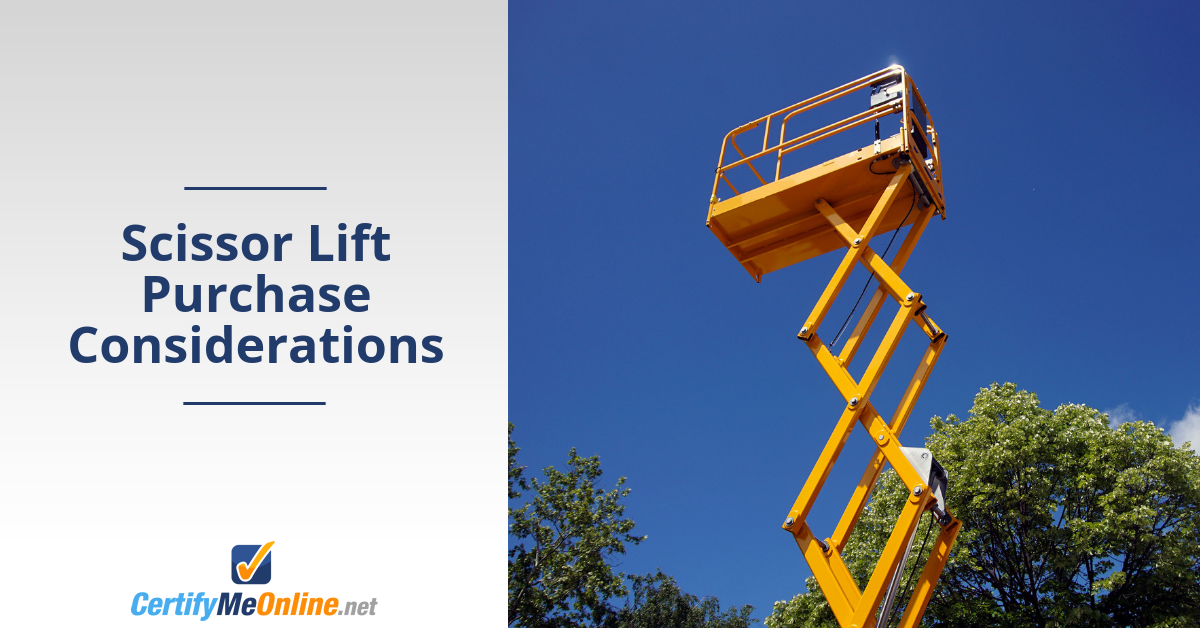Scissor Lift Purchase Factors You Need to Know
Do your employees work above ground on a regular basis? If so, you may be thinking about buying a scissor lift. Scissor lifts offer several benefits for companies that engage in above-ground work. They can be used indoors and outside. They replace the need for ladders, towers or scaffolding. They allow operators to complete jobs quicker by reducing setup times. The platforms can hold many different types of equipment needed for a job. Most important, scissor lifts provide safe access to hard-to-reach areas.
Clearly, there are many advantages to using a scissor lift. But buying one does require a big investment. So before you make the big decision, here are some important factors you need to know.
Choosing the Right Scissor Lift for Your Business
A scissor lift is a motorized vehicle with a sturdy platform that can only be raised straight up into the air. The platform cannot be moved horizontally as with other types of aerial lifts. Scissor lift types include fixed, mobile, electric and rough terrain.
Mobile scissor lifts are generally used for outdoor projects that require travel to get to the job site. Fixed scissor lifts are typically used inside warehouses and other industrial structures. Electric scissor lifts are best for tasks that take place in level, easy to reach areas. For example:
-Maintaining structures
-Seasonal maintenance tasks
-Accessing warehouse shelves
-Cleaning gutters and windows
-Replacing light bulbs or signs
-Repairing high-mounted equipment
-Work that requires lifting heavy materials or equipment
-Tasks that require lifting multiple workers
Rough terrain scissor lifts are designed for outdoor projects where stability is of vital importance. These can include:
-Constructing or repairing buildings
-Fixing or inspecting utilities
-Installing signage
-Finishing landscape work
-Moving goods at a railyard
-Working on unpaved roads or gravel
Needs and Site Assessment
Before you begin shopping for a scissor lift, be sure to determine how and where you will use it. This will help determine the type of lift, its capacity and any extra features you may need. First, identify the scissor lift’s primary function. Is it to provide access to hard-to-reach areas, lift heavy loads or both? The consider the following:
Environment: Will the lift be used indoors or outdoors?
Jobs: What type of work will you be performing with the lift?
Emissions: Does the work area have strict emission codes?
Terrain: Is it smooth or rough? Can it safely support heavy equipment?
Work heights: What is the maximum height your scissor life will need to reach?
Weather: What are weather conditions like on your work sites?
Frequency of use: How often will you use the scissor lift? For how long?
Safety features: What safety features, such as emergency buttons and safety bars, will you need for maximum worker safety?
Load capacity: How much weight will the scissor lift need to support?
Clearance: If used indoors, what is the clearance when working in aisles or other narrow workspaces?
Budget
Buying a scissor lift is no small expense. The bigger they get, the more they cost. After the initial purchase price, you still have the cost of training all workers who will use the lift. You also have to account for maintenance labor and replacement parts. Fortunately, there are ways to minimize the total cost.
Buying used rather than new can save a lot of money. The downside is you don’t get the warranty of a new lift. Plus, a used scissor lift has a shorter life cycle. But if the lift has been well-maintained and you only need it for light to moderate use, buying used might be the right decision.
You can also rent rather than buy. This option works well if you only need the scissor lift for occasional work. Renting also saves the cost of storing and maintaining the lift, and the cost of transporting the lift to the job site. When renting, the rental company will deliver it for you.
Finally, determine whether the benefits of buying a scissor lift outweigh the costs. These can include:
-Reduced medical and workers comp costs through improved safety
-Improved productivity
-The ability to take on bigger or more jobs
Training and Certification
On average, there are 26 deaths a year in the U.S. due to aerial lift accidents. In many cases, they result from operator error or negligence. If you buy a scissor lift, training and certification for employees is not just an OSHA requirement. It’s the right thing to do. You owe it to your employees to provide a safe working environment. With aerial lifts, that means approved training and certification for all who work in and around them. Scissor lifts will often have more than the operator on board. Everyone on the lift should be trained on aerial lift safety.
Keep in mind that the American National Standards Institute (ANSI) recently released updated standards for aerial lift safety and training. When you send employees for training, make sure to use a company that trains and certifies to the new standards.
